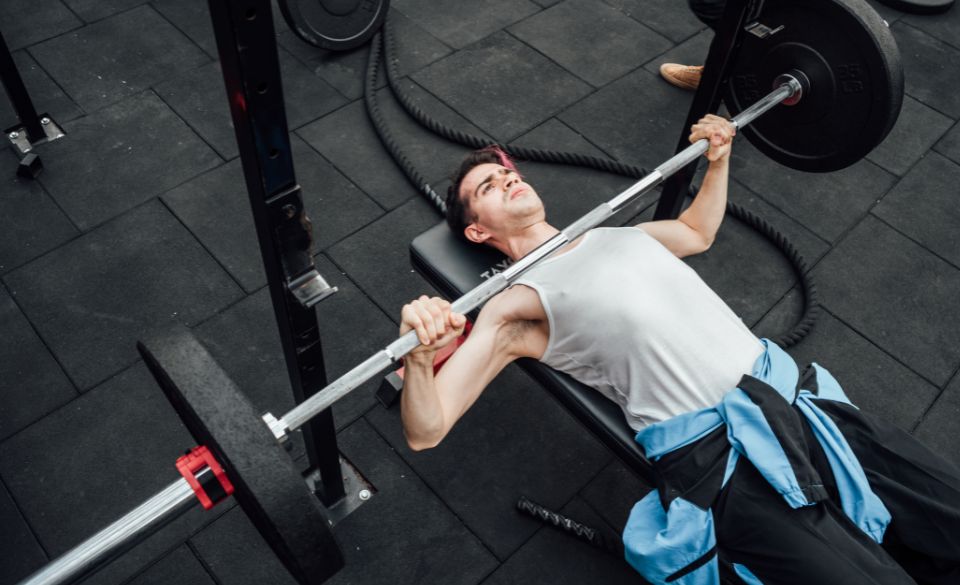
What Causes Forearm Pain When Benching
Page Contents
Forearm pain when benching is a common complaint among weightlifters and can be one of the most debilitating injuries that can derail progress and leave one feeling frustrated and unmotivated. Fortunately, diagnosing and managing this type of pain is relatively straightforward, and with the right approach, it can be managed effectively. In this article we discuss what causes forearm when benching.
What Causes Forearm Pain When Benching
One of the most common causes of forearm pain when bench pressing is overuse. This happens when the muscles of the forearms are exposed to more stress than they can handle. This can be due to using heavier weight than normal, performing too many sets or reps, or even maintaining an improper grip during the lift. All of these activities require the muscle to exert more force than it’s used to, leading to overuse and pain.
Aside from overuse, some people may experience forearm pain when benching from poor technique. This could include not engaging the lats or core, not maintaining a good posture or not keeping the wrists and elbows in an optimal alignment. All of these factors can cause the forearms to be overworked and can lead to tendonitis and pain in the forearms.
Another common cause of forearm pain when benching is inadequate warm-up. Before any workout, the muscles need to be properly warmed up and activated. Without this important step, the muscles will be cold and unable to handle the stress of the exercise, which can lead to inflammation and pain.
Finally, an improper grip when benching can also cause forearm pain. Whether it’s too wide or too narrow, an incorrect grip can put excessive strain on the wrists, elbows, and forearms, leading to pain. If a lifter isn’t sure what the correct grip width should be, they should ask their trainer or a qualified instructor for advice.
Managing forearm pain when benching requires an understanding of the underlying cause. With proper rest and modification of activities and technique, most cases can be efficiently managed and the lifter can return to their normal routine.
How To Bench For The First Time
Bench press is an iconic lift that has stood the test of time in the weight room. It has been around for decades and is often seen as the foundation of any weightlifting program. If you’re just getting started in the world of weightlifting, it’s important to know how to bench properly and safely. Here’s a guide to help you bench for the first time.
1. Get set up properly: Before you begin lifting, make sure you’re setting yourself up in the bench press rack properly. Lie on the bench so that your eyes are even with the bar. Position your feet firmly on the ground and make sure your back is flat against the bench.
2. Grip the bar: Once you’re comfortable with your position, grip the bar in both hands. It should be over your chest with an overhand (palms facing away from you) grip. Your hands should be slightly wider than shoulder-width apart.
3. Unrack the bar: This can be done with a spotter or by pressing the bar up off of the hooks you’re resting it on. Make sure to keep your arms extended and your back flat against the bench. Take a few seconds to realize whether or not you are in proper form before continuing.
4. Lower the bar: Take a deep breath and lower the bar down to your mid-chest level. Keep your elbows tucked close to your body and press the bar in a straight line. This will help ensure that you’re using the most muscles possible.
5. Extend the bar: As you reach the bottom of the motion, extend your arms backwards to lift the bar off of your body. When you reach the top, pause for a second then reluctantly drop the bar back down to the starting position.
Bench press is an essential exercise for any weightlifter and should become a regular part of your training. It’s important to understand proper form and technique before attempting the lift, but if you follow the steps above, you’ll have no trouble making the bench press a part of your routine.
How To Bench Properly
Do you struggle with being able to perform bench presses correctly, so you can get the most out of them? If so, you’re not alone. Learning how to do bench presses correctly takes practice and patience, but once you master the basics, you’ll be able to increase your strength and the amount of weight that you can lift.
To begin, make sure you have the right setup. Start by positioning the bench in the middle of a power rack at the correct height, according to your height. Ideally, your back should be flat when lying down on the bench. The bar should be lined up directly over your eyes when looking up. When gripping the bar, your hands should be just wider than shoulder-width apart.
When performing the bench press, focus on using your chest and legs to push the bar off of the rack, rather than using your arms. This will help ensure that the bar is traveling in an even line up to your chest, rather than shooting up. Focus on pressing the bar away from you, squaring your shoulders at the top of the press and not arching your back or shoulders. You should also make sure that your glutes are dug into the bench, helping to keep your torso in line with your upper legs.
When controlling the bar back down to the rack, keep your arms parallel to the floor, rather than letting them go wider than your shoulders. This will help to prevent any strain on your shoulders, and make sure you’re doing the exercise correctly.
When you’re comfortable with these basics, you can begin to add some variations to your bench press. You can try using a narrower grip, which will help to engage different muscles. You can also perform a pause bench press, where you pause briefly in the bottom position of the press and at the top, to add more intensity and better target the muscles.
Remember, the key to bench pressing properly is practice and patience. If you focus on the basics and follow the right form, you’ll be able to have greater success and get the most out of your bench press exercises.


